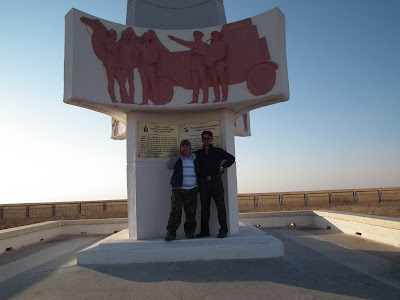However recent statues reflect a Mongolian identity. According to a Buriat legend birds were involved in creation and this statue shows woman emerging from a swan. Buriat are a distinct ethnic group in Russia and northern Mongolia.

Borte was Chinggis Khan's wife and born in Dornod aimag, fed up with her sons quarreling she gave each of them an arrow and asked them to break it with their hands which they did easily, she then took five arrows together and asked them to break them, but they could not. If you are united you are strong, separate you are weak.
I was in Choibalsan for a tourism conference organised by regional government. The aimag government is committed to developing cross-border tourism with Russian and Chinese neighbours and the Ministry is supporting this with proposals to build two tourism complexes. At first glance this makes sense, Dornod is far from UB and other international tourists. However development of cross-border tourism requires a change in policy from the Border Agency which does not wish to increase the number of border crossings. Everywhere in Dornod there was evidence of Chinese investment: Chinese mining companies drilling for oil, a Chinese funded irrigation scheme ploughing large areas of virgin lands for wheat, a Mongolian/Chinese tourist camp.
After the conference I traveled to the eastern border with Batbold, Head of protected areas, Gansorlig Tourism Official. and Baljimaa my interpreter. This trip was entirely arranged and funded by the aimag government so we did not have the regulations of international organisations like Mercy Corps. We had our first vodka at 8 am less than 10 minutes after leaving town, every meeting was accompanied by vodka, and at every departure there was more vodka on the edge of town. I stayed sober, politely sipping the drink rather than emptying the glass as encouraged by Batbold. Not surprsingly Batbold and Gansorlig ended the day pretty drunk but they were generally good company.
Dornod has the largest area of natural grassland in the world with an estimated two million gazelle and is described by conservationists as one of the last great wildernesses in the world, the locals seem surprised by this description.Gazelles are fine but tourism potential is limited, a bit like watching cows graze, and the landscape is very flat, fine if you like grass.
At Ikh Burkhant there is a large Buddha monument lying on the hillside, it was built by a local Khan in 1864v so that local Mongolians would not have to make a pilgrimage to Tibet.
Khalkgol was the site for Mongolian Russian defeat of Japanese army in 1939. The Mongolians take great pride in this victory, they were the only Asian country to defeat the Japanese. There are numerous monuments in the countryside and a museum in Khalkgol soum.
In communist times Khalgol soum was an important border town with flights from Russia however much of the Russian investment stopped in 1990 and now parts of the town are derelict. It reminded me of some of the small towns in Kazakhstan.
We then travelled east to Nomrog protected area, this was an uninhabited landscape of grassy plateaus, rolling hill sides and marshy valleys. There are no herders here but we stayed at Military border police.
Even in this remote area there was evidence of Chinese investment.
I had little time for birding but managed a few pictures of local wildlife. An account of birds on my recent trip to Gobi is on birds mongolia website. I was also pleased to see Asian Greenfinch which was a new species for me.



























No comments:
Post a Comment